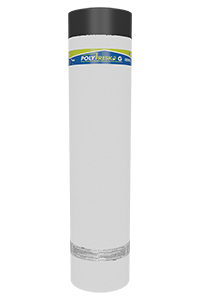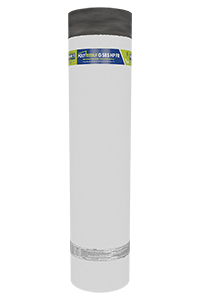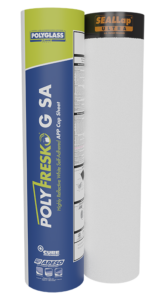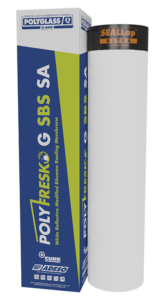Due to the wide surface area that they cover, roofing systems for low-slope roofs get their fair share of exposure to different weather conditions. Prolonged rain, UV, and wind exposure can significantly reduce a roofing system’s performance and overall lifespan. As a result, repairs need to be made, and costs that could’ve been avoided altogether have to be provisioned for.
Let’s look at how Polyglass’ uniquely designed low-slope roofing membranes help protect roofs from UV deterioration while increasing a building’s energy efficiency and reducing its environmental impact.
Cool Roofs – A Recap
Keeping buildings cool is as much a need for comfort as it is necessary. When looking for solutions to cooling a building, the first place to look is the widest surface area that the sun’s rays hit – often its roof. When relentless UV rays penetrate a roof’s structure, they can cause many problems, including energy wastage, excess interior heat, and decreased roof durability.
Challenge 1: Energy efficiency
Did you know that your energy bill increases for every minute your roof does not have a reflective surface? As the building’s interior heats up from its roof, more energy is needed to power air conditioners to cool the interior climate. Installing a reflective roof helps redirect UV rays into the atmosphere, and reduces heat penetration, ultimately saving energy.
Challenge 2: Increased humidity
Rising temperatures within a building from heat absorbed through a roof aren’t just unbearably hot but also give way to humidity and, worse, mold or structural damage. Any crawl spaces, bathrooms, and attics without sufficient ventilation are areas prone to humidity build-up. Even windows, doors, and plumbing, when not properly sealed, provide an entry point for humidity to set in.
Challenge 3: Urban heat island effect
Every urban area started as a rural area. Tar roads, pavements, and buildings made of concrete and asphalt – materials that absorb heat instead of reflecting it – replaced the trees and grass that cooled the land as precipitation occurred. An urban heat island forms without the natural systems that allow surfaces and air to cool off, which increases ambient and indoor temperatures.
Challenge 4: Roof system durability
Blistering, deterioration and damaged sealants are a few ways UV rays decrease a roof system’s reliability.
- Blistering: The first stage of blistering occurs when cracks or holes develop on a roof’s surface. The actual blister appears when water enters these cracks and expands, lifting the tar paper or roofing felt. Blistering loosens roofing granules that protect the roof from the harsh effects of the weather, leaving the roof vulnerable to further damage.
- Deterioration: Because the roof is made up of chemicals, UV rays attack the composition of the roof’s surface. Over time, direct exposure to sunlight causes these chemicals to deteriorate. Deterioration affects the roof’s water-shedding performance and, when left for too long, it could cause the roof to fail prematurely.
- Damaged Sealants: Sealants protect the roof against damaging elements like rain, snow, and ice. However, UV radiation breaks down the chemicals in roof sealants, compromising their integrity. Once this happens, the entire roof will lose its structural integrity giving way to tears, breaks, and even worse, collapse.
As volatile organic compound (VOC) regulations have tightened over the years, the need for cooler roofing solutions has increased. Different state-based Cool Roofing codes, standards, and ordinances have also pressured manufacturers into developing more sustainable roofing products, known as “cool roofs.”
Cool roofing products now outpace traditional roofing materials in popularity due to their ability to reflect solar energy (ultraviolet sunlight) and cool themselves by emitting thermal heat. They help extend a roof’s lifespan and are also more energy-efficient.
Polyglass Kool Roof Solutions
Polyglass’ Kool Roof Solutions™ offers innovative cool roofing products for building owners, roofing contractors, and specifiers. Our white membranes and elastomeric roof coatings comply with Title 24, Part 6 of the 2016 California Building Energy Efficiency Standards and are formulated to help reduce UV deterioration, increase reflectivity, and significantly extend a commercial or residential roof’s lifespan.
Polyfresko® APP and SBS CAP Sheets
Our Polyfresko® Atactic Polypropylene (APP) and Styrene-Butadiene-Styrene (SBS) modified bitumen membranes are available as self-adhered (SA) and heat-welded membranes. They are equipped with patented thin-film CURE Technology® providing a minimal surface finishing for improved reflectivity and protection from ultraviolet rays. Our Polyfresko range has also been designed to resist asphaltic bleed and color staining to retain their reflectivity and color integrity.
 Polyfresko G
Polyfresko G
Polyfresko G is a plastomeric granulated cap sheet used in low-slope roofing. Made from the highest quality non-woven polyester reinforcement, it is flexible, dimensionally stable, and tear and puncture-resistant.
The exceptional granule retention, scuff resistance, and UV stabilization for long-term durability and performance are from a thin innovative technology known as CURE Technology.
With an initial Solar Reflectance Index (SRI) of 96 and 82 (3-year weathered), Polyfresko G is suitable for most cool roof specifications.
Polyfresko G maintains exceptional reflectivity over time – proving that it has staying power. It is resistant to discoloration and scuffing so that it stays looking presentable and is damage-free for a long time. Polyfresko G’s premium membrane construction makes it one of the strongest on the market, and it has granule retention of 0.09 g loss vs. the minimum requirement set forth by ASTM (2.0 gram-loss).
Polyglass products have proven that your low-roof will be durable for many years to come.
 Polyfresko G SBS FR
Polyfresko G SBS FR
Another cool roof membrane offered by Polyglass is Polyfresko G SBS FR. This elastomeric granulated cap sheet is of premium quality with fire-retardant additives. Non-woven polyester reinforcement provides flexibility and dimensional stability as well as excellent tear and puncture resistance.
CURE Technology® is also used in Polyfresko G SBS FR. This highly reflective granule surface meets, or exceeds, most standards for cool roofing. And, it doesn’t stop there.
The Polyglass’ patented ADESO® Self-Adhered Technology allows for quick and easy installation, while innovations such as FASTLap® and SEALLap® Ultra enable exceptional watertight seams.
 Polyfresko G SA
Polyfresko G SA
Polyfresko G SA is a self-adhered Atactic Polypropylene (APP) granulated cap sheet for low-slope roofs. It is intended for use as the primary weathering surface in new or re-roof applications. It offers a highly reflective granule surface (with an initial SRI of 96 and 83 aged) that meets or exceeds most standards for cool roofing.
Polyfresko G SA is also manufactured using ADESO SA and CURE Technologies.
 Polyfresko G SBS SA
Polyfresko G SBS SA
Polyfresko G SBS SA is a self-adhered Styrene-Butadiene-Styrene (SBS) granulated cap sheet for low-slope roofs. Here, a “true” elastomeric compound is applied to the top of the membrane, and an aggressive self-adhesive compound is applied to the bottom.
Constructed with a superior non-woven polyester reinforcement, Polyfresko G SBS SA provides excellent tear and puncture resistance, flexibility, and dimensional stability.
PG and Polybrite White Elastomeric Roof Coatings
Polyglass’ PG and PolyBrite® white elastomeric roof coating products provide industry-leading reflectivity and UV protection, helping to keep building temperatures cool. These coatings are some of the best roof solutions ideal for most roofing substrates, including polyurethane foam, modified bitumen, plywood, and concrete.
The coatings use proprietary formulations to reduce roof temperatures and offer a unique ability to extend a roof’s lifespan. They cure to form a seamless liquid-applied roof membrane. Suitable for new construction and re-roofing, each system provides high tensile strength and elongation, as well as resistance to fungus, algae, and dirt pickup.
Why Install a Polyglass Kool Roof?
Take a look at how Polyglass meets and exceeds industry reflectivity ratings.
Designed to provide incomparable coverage for virtually all that Mother Nature can subject it to, Polyglass’ extensive product line of self-adhered modified bitumen membranes is the answer to a range of residential and commercial roofing challenges.
Contact us today for technical advice on the best cool roof materials for your own roofing projects.




